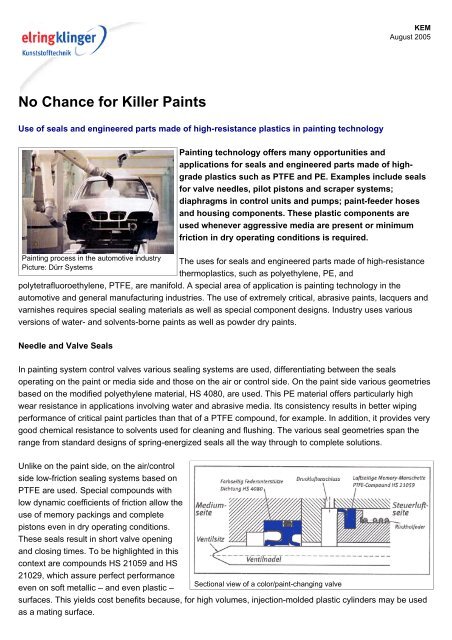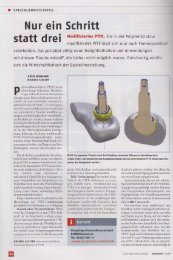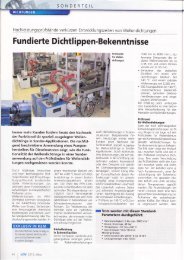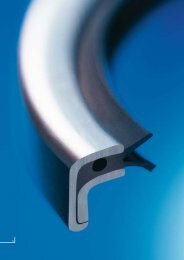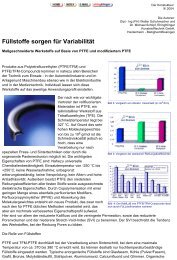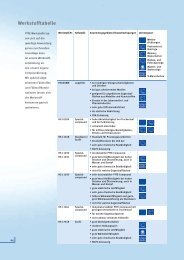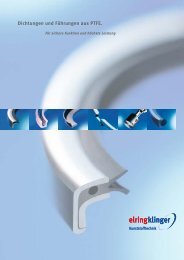No Chance for Killer Paints - ElringKlinger Kunststofftechnik
No Chance for Killer Paints - ElringKlinger Kunststofftechnik
No Chance for Killer Paints - ElringKlinger Kunststofftechnik
You also want an ePaper? Increase the reach of your titles
YUMPU automatically turns print PDFs into web optimized ePapers that Google loves.
<strong>No</strong> <strong>Chance</strong> <strong>for</strong> <strong>Killer</strong> <strong>Paints</strong><br />
Use of seals and engineered parts made of high-resistance plastics in painting technology<br />
Painting process in the automotive industry<br />
Picture: Dürr Systems<br />
KEM<br />
August 2005<br />
Painting technology offers many opportunities and<br />
applications <strong>for</strong> seals and engineered parts made of highgrade<br />
plastics such as PTFE and PE. Examples include seals<br />
<strong>for</strong> valve needles, pilot pistons and scraper systems;<br />
diaphragms in control units and pumps; paint-feeder hoses<br />
and housing components. These plastic components are<br />
used whenever aggressive media are present or minimum<br />
friction in dry operating conditions is required.<br />
The uses <strong>for</strong> seals and engineered parts made of high-resistance<br />
thermoplastics, such as polyethylene, PE, and<br />
polytetrafluoroethylene, PTFE, are manifold. A special area of application is painting technology in the<br />
automotive and general manufacturing industries. The use of extremely critical, abrasive paints, lacquers and<br />
varnishes requires special sealing materials as well as special component designs. Industry uses various<br />
versions of water- and solvents-borne paints as well as powder dry paints.<br />
Needle and Valve Seals<br />
In painting system control valves various sealing systems are used, differentiating between the seals<br />
operating on the paint or media side and those on the air or control side. On the paint side various geometries<br />
based on the modified polyethylene material, HS 4080, are used. This PE material offers particularly high<br />
wear resistance in applications involving water and abrasive media. Its consistency results in better wiping<br />
per<strong>for</strong>mance of critical paint particles than that of a PTFE compound, <strong>for</strong> example. In addition, it provides very<br />
good chemical resistance to solvents used <strong>for</strong> cleaning and flushing. The various seal geometries span the<br />
range from standard designs of spring-energized seals all the way through to complete solutions.<br />
Unlike on the paint side, on the air/control<br />
side low-friction sealing systems based on<br />
PTFE are used. Special compounds with<br />
low dynamic coefficients of friction allow the<br />
use of memory packings and complete<br />
pistons even in dry operating conditions.<br />
These seals result in short valve opening<br />
and closing times. To be highlighted in this<br />
context are compounds HS 21059 and HS<br />
21029, which assure perfect per<strong>for</strong>mance<br />
Sectional view of a color/paint-changing valve<br />
even on soft metallic – and even plastic –<br />
surfaces. This yields cost benefits because, <strong>for</strong> high volumes, injection-molded plastic cylinders may be used<br />
as a mating surface.
Diaphragms in Pressure Control Systems<br />
To per<strong>for</strong>m painting processes at a constant paint pressure level of app. 20 bar control valves use<br />
diaphragms made of polytetrafluoroethylene, PIPE, and – in the latest applications – of polyethylene, PE, as<br />
well. The diaphragms serve to separate the paint and control air and to keep the paint pressure at a constant<br />
level in order to assure flawless painting. For these applications, pure PTFE diaphragms made of HS 17022<br />
and HS 17004 are used. These two materials are characterized by particularly high flexibility, reverse bending<br />
strength, the chemical resistance of PTFE and high pressure stability.<br />
Geometrically, such diaphragms can be fabricated as flat or beaded diaphragms, depending on the design of<br />
the pressure control unit. Latest applications have shown that as a diaphragm material the polyethylene<br />
material, HS 4080, gives very good pressure stability and reverse bending strength as well.<br />
In view of today's environmental requirements and price increases <strong>for</strong> paints it is necessary that with state-ofthe-art<br />
painting systems and robots provisions be made <strong>for</strong> recovering any excess paint from the hose lines.<br />
For this purpose, specific sealing solutions, so-called hose scraper systems, have been developed. They<br />
serve to push back the paint in the plastic hoses, thus allowing this paint to be recovered and used.<br />
The author, Klaus Hocker, is an<br />
application engineer with<br />
<strong>ElringKlinger</strong> <strong>Kunststofftechnik</strong><br />
GmbH, Bietigheim<br />
<strong>ElringKlinger</strong> <strong>Kunststofftechnik</strong> GmbH<br />
Tel: +49-(0)7142-583-0<br />
Etzelstraße 10 Fax: +49-(0)7142-583-200<br />
D-74321 Bietigheim - Bissingen Email: info@elringklinger-kunststoff.de


